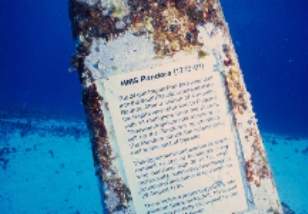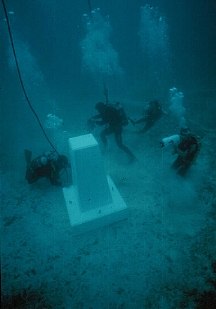
Figure 12: Photograph of the monument containing the 1986 skeletal material, placed at the wreck site in 1993.
Image used courtesy of the Queensland Museum

Figure 12: Photograph of the monument containing the 1986 skeletal material, placed at the wreck site in 1993.
Image used courtesy of the Queensland Museum
The first glimpse of the human skeletal remains from the Pandora came during the 1986 expedition to the wreck. Queensland Museum archaeologists were carrying out systematic excavation on the stern section of the ship, when the surprising discovery was made (Gesner 1991, 43). The first impression was that they were the remains of one of the four Bounty mutineers who were lost with the ship (in actual fact, only one mutineer, Henry Hildebrandt, went down whilst inside Pandora's Box). This theory is, however, unlikely. Forensic analysis of these skeletal remains was later carried out by Wood and Hodgson ( 1996), who demonstrated that the material was consistent with being derived from one individual. Thought likely to be the sole Pandora skeleton, Queensland Museum archaeologists de-accessioned the remains and they were re-interred at the wreck site inside an obelisk, consecrated by an RAN chaplain, in 1993 (Figure 12 and 13).
 >
>
Figure 13: Photograph of the monument containing the 1986 skeletal material being placed at the wreck site in 1993
Image used courtesy of the Queensland Museum
But once again, and unexpectedly, Pandora gave up more human remains during the 1995 expedition. Found in a slightly different area of the stern, and consisting of only two bones, the question of whether the remains of another individual were present in the wreck promptly arose. Further expeditions from 1996 to 1998 produced more than 200 individual human bones or bone fragments, originating from different areas of the stern including three mandibles - clearly indicating that more than one individual was present. The rest of this article concentrates on the skeletal material recovered from the stern sections of the wreck, excluding the remains located during the 1986 expedition. Information compiled from the 1986 material is, however, included in the overall analysis.
© Internet Archaeology
URL: http://intarch.ac.uk/journal/issue11/4/12.html
Last updated: Thu Mar 28 2002